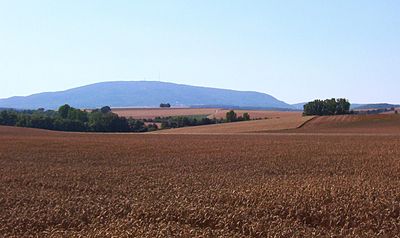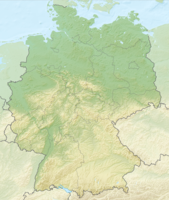The region Thunder Mountain belongs to Northern Palatinate and lies in Rhineland-Palatinate. It is named after the 687 m high Donnersberg, which can be seen from afar and is the highest mountain in the Palatinate. The Donnersberg region roughly coincides with the area of today's Donnersbergkreis, with minor differences in the border regions.

| location | ||
places

- 1 Kirchheimbolanden
 , District town with partially preserved city wall
, District town with partially preserved city wall - 2 Rockenhausen

- 3 Dannenfels
 - Climatic health resort on the Donnersberg info
- Climatic health resort on the Donnersberg info - 4 Falkenstein (Palatinate)

- 5 Goellheim

background
The Donnersberg region was, like many German regions, strongly fragmented in history. Some areas such as Kirchheimbolanden belonged to Nassau-Weilburg, others belonged to the Electoral Palatinate, others were ruled by local landlords. Even today, this fragmentation is reflected in some ways. While the northwest with the towns of Alsenz and Obermoschel is already oriented towards Bad Kreuznach, the cities in the south commute to Kaiserslautern, while Kirchheimbolanden is the preferred residential area for employees in Alzey, Mainz and Frankfurt.
Neighboring regions are: Palatinate highlands, Rheinhessen with the Nahe valley, the German Wine Route, the Palatinate Forest with the Leiningerland.
language
In the Donnersberg region, as in the whole of the Palatinate, Palatine is spoken. However, this is not the same in the whole region: while in the east, especially in Kirchheimbolanden, a transition dialect to Hessian is already spoken, in the west around Rockenhausen a separate dialect is predominant, which is roughly based on the western Palatinate.
getting there
In the street
The classic way of arriving by car is via the A 63 motorway, which crosses the region to the east. From here, the entire region can be reached by well-developed country roads.
Coming from the north on the A 63, the motorway at 1 Leave junction "Kirchheimbolanden" (11). Drive over the east bypass from Kirchheimbolanden towards Dannenfels.
Those arriving from the south leave the Autobahn 63 on 2 Connection "Göllheim" (12). From here via Weitersweiler and Bennhausen to Dannenfels (already at an altitude of 350 to 400 m).
From Dannenfels driveway on the steep county road "K 51" to the summit or alternatively from here on foot to the summit. There is a parking space at the exit to Steinbach at 3 (Small, free space with only around 15 parking spaces, but mostly less frequented).
More parking spaces are in the article Dannenfels listed.
By train
Possible ways to get here by train are:
- over the route from Alzey with the end point in the train station Kirchheimbolanden. Here regional trains run every hour from Mainz via Alzey.
- on the Mainz - Kaiserslautern route in the train stations Alsenz, Rockenhausen and Winnweiler. This route is also served hourly by regional trains.
- over the route from Frankenthal at the train station Eisenberg (Palatinate), which is also served every hour.
mobility
Anyone who wants to be mobile should have their own car. There is a public transport network on Donnersberg, but this is largely geared to the needs of the students who have to be brought to their schools and is therefore unusable for travelers, especially because, with very few exceptions, there is a shutdown on weekends. There are relatively few bus connections that are also interesting and, above all, useful for tourists, including the RegioLinie 920 between the Kirchheimbolanden and Eisenberg (Palatinate) train stations with service even on weekends.
The network of on-demand connections in public transport is designed to be quite confusing for outsiders. On the one hand, there are the classic "call taxis". Contrary to our own assertion, you cannot reach every place in Donnersberg with the call taxis (Ramsen and especially the very popular Eiswoog excursion destination is left out ...), and the connections are sometimes very cumbersome with multiple changes even between call taxis from different operators for certain routes. In addition, times when regular (school) buses also run are omitted from the call taxi offer, even in places that are not served by these buses. The only plus point: there are also scheduled trips on weekends (usually every two hours). IMPORTANT: VRN tickets are sold in the Ruftaxi Not recognized (except for half-yearly and annual tickets), a new ticket must always be purchased, even if the prices correspond to the VRN tariff.
Then there is the "leisure taxi". That would be interesting with his system without fixed routes between any two stops in Donnersberg, but unfortunately it is not worth mentioning in practice because it is only available in the off-peak times (i.e. late in the evening after 7 p.m. to midnight, only on weekends at 6 a.m.) can be used. In addition, the Ruftaxi switchboard is only manned for this special offer during normal office hours, i.e. not on Friday afternoons, nor on weekends and public holidays. Meaningful trip planning is of course impossible.
Note: Disabled people are generally not taken on the buses, instead a special "handicapped taxi" must be ordered, for which a surcharge has to be paid. This rule, which is probably unique in Germany and is extremely hostile to the disabled, should prevent every wheelchair user without a car from making a detour in the region.
Cycling is completely unusual in the region, there is also no infrastructure for cyclists - there is not a single bike rental in the entire region, there are nowhere bike racks and bike paths - with a few exceptions - will also be missed. The topography makes cycling a torture anyway, only in Alsenztal, Zellertal and along Kaiserstraße is it flat enough that cycling can also be recommended to recreational cyclists.

Tourist Attractions
- The Thunder Mountain Even at Dannenfels is of course the classic sight with a lookout tower and Celtic wall (for information see article Dannenfels).
- Imsbach mining adventure world with the "White Pit" visitor mine and the Palatinate Mining Museum info
- Falkenstein castle ruins - The ruin sits enthroned on a cliff near the village of the same name, which is west of the Donnersberg.
- Celtic village in Steinbach - Experience the history of the Celts with all your senses.
activities
To the hike the Donnersberg region is ideal. Hikers can relax in the vast forests, especially in and around the mountain itself and near Kirchheimbolanden. The region is anything but flat and if you are untrained, you will run out of breath relatively quickly.
accommodation
The next place with some guest beds to the summit is Dannenfels .
General: Accommodation see otherwise www.donnersberg-touristik.de
security
health
Important: In the Donnersberg region the emergency number is still 19222! The 112 takes you to the fire brigade, which cannot help with medical emergencies.
climate
The climate is considered to be rough, cool and, especially at high altitudes, relatively windy. That's why you don't see any vineyards on the Donnersberg, as they are otherwise part of the landscape in almost all of Rhineland-Palatinate, but all the more wind turbines. If you want to go outside in the cold season, you should be careful, as the cold wind is often underestimated and can lead to life-threatening hypothermia.
On the other hand, you don't necessarily have to expect snow: the Donnersberg is one of the regions in Germany with little precipitation, as the mountains in the west keep the rain clouds away.
literature
- Palatinate Forest Nature Park - The Donnersberg 1: 25,000 - official topographical leisure map with hiking trails, ISBN 978-3-89637-397-7 (2nd edition 2010), € 6.90, published by the State Office for Surveying and Basic Geographic Information Rhineland-Palatinate
Web links
- http://www.donnersberg-touristik.de - Official website of Donnersberg






